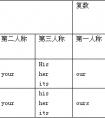按要求进行句型转换。1.There are some kites on the wall.(改为否定句)________________________________________2.There is some rice in the bag.(改为一般疑问句) _-七年级英语
In the tree there are five birds. 树上有五只鸟。
There be结构时态:
1.There be 句型中动词be可以有一般现在时、一般过去时、将来时和完成时。
There is no harm in trying.不妨一试。
There were fabulous wildflowers in the hills last spring.去年春天,山中有极美的野花。
There will be a fine day tomorrow.明天将是一个晴天。
There have been several private schools in our area this year.今年,我们这里已经有好几所私立学校了。
2.There be 句型可以和各种助动词、情态动词连用。
There may be a cigarette in that box.那只盒子里或许有支香烟。
There must be some cakes on the table.桌子上一定有些蛋糕。
There used to be a hospital there before the war.战前,那里曾经有家医院。
3.There be 句型也可以和这样一些的谓语动词连用:be going to 、seem to 、appear to 、used to、be likely to 、happen to ….
There seem to be a few trees between me and the green.在我与草坪之间好像有一些树。
There is gong to be a meeting tonight.今天晚上有个会议。
There is likely to be a storm.可能有一场暴雨。
There happened to be a bus nearby.碰巧附近有辆公交车。
There appears to have been a nasty accident.似乎发生了一起严重事故。
4.there be 结构中除可以用be 外,还可以用其它动词。例如:
There came a scent of lime-blossom.飘来一阵菩提树的花香。
Once upon a time there lived a king in China.从前中国有一个国王。
There be 结构的非谓语动词形式是there to be 和there being 两种形式。在句中作主语、宾语和状语。
1. there being 结构起名词的作用,直接位于句首作主语,通常用it 作形式主语,并且用for引导。
There being a bus stop near my house is a great advantage.我家旁边有个公共汽车站,很是方便。
It is impossible for there to be any more.不可能再有了。
2. there be 结构作宾语时,通常用there to be ,常作这样一些词的宾语:
expect,like, mean, intend, want,prefer,hate等。
I expect there to be no argument about this.我期望关于这件事不要再争吵了。
I should prefer there to be no discussion of my private affairs.我宁愿不要讨论我的私事。
People don’t want there to be another war.人们不希望再有战争了。
另外,作介词宾语时,如果是介词for,只能用“there to be”其它介词用“there being”
The teacher was waiting for there to be complete silence.老师在等着大家都安静下来。
I never dreamed of there being any good chance for me.我做梦也没想到我会有好机会。
3. 作状语的there be 形式,通常用“there being”结构。
There being nothing else to do ,we went home.因为没有其他事可做,我们就回家了。
They closed the door ,there being no customers.因为没有顾客,他们的店关门了。
考点名称:一般疑问句
- 一般疑问句:
是疑问句的一种。通常用yes,no来回答的疑问句叫做一般疑问句。口语中若无特殊含义,句末用升调。
其结构是:系动词be/助动词/情态动词+主语+其他成分?
通常回答为:
肯定:Yes+主语+提问的助动词
否定:No+主语+提问的助动词+not
例如:
Are you from Japan? Yes, I am./No, I'm not.
Do you live near your school? Yes, I do./No, I don't.
Can you speak French? Yes, I can./No, I can't. - 一般疑问句的特性:
1.将陈述句变为一般疑问句时,如句中有be 动词(am/ is/ are)时,可直接将它们提至主语前。
如主语为第一人称,应将其改为第二人称。如:
I'm in Class 2Grade 1. →Are you in Class 2Grade 1﹖
We're watching TV. →Are you watching TV﹖
2.陈述句中有情态动词(can、may、must …)时,也可直接将它们提至主语前,即可成为一般疑问句。如:
He can swim now. →Can he swim now﹖
The children may come with us. → May the children come with us﹖
3.陈述句中只有一个实义动词作谓语且其时态为一般现在时,变为一般疑问句时要在句首加do或does主语后的实义动词用原形。如:
I like these animals. →Do you like these animals﹖
She wants to go to the movies. → Does she want to go to the movies﹖
4.一般疑问句一般读升调(↑)
5.一般疑问句有时不用yes或 no 回答。如:
Are they in town now﹖
I think so.
May I sit here﹖
Certainly.
Does he like soccer﹖
Sorry I don't know.
6. 一般疑问句的第一单词总是虚词,读的时候要读轻声。 - 陈述句变为一般疑问句技巧:
根据一般疑问句不同的家族,可以用不同的方法将陈述句变为相应的一般疑问句。
1、第一家族:含be动词或情态动词的句子
秘诀:一调二改三问号
一调:即把句中的be或情态动词调到主语前;
二改:改换主语称谓,即将句中的主语I\my \mines\we\our\ours等。第一人称分别改为相应的第二人称you\your\ yours等;
三问号:句末的句号改为问号。如:
Eg. I am an English teacher. → Are you an English teacher?
Eg. We can speak English fluently. → Can you speak English fluently?
2、第二家族:含行为动词(或称为实义动词)的句子
秘诀:一加二改三问号
一加:即在句首加助动词Do或Does;
二改:1、把谓语动词改为原形;2、改换主语称谓(同第一家组);
三问号:句末的句号改为问号。
Eg. We read English every morning. → Do you read English every morning?
Eg. Tom’s father listens to English on the radio every evening. →Does Tom’s father listen to English on the radio every evening?
特别注意:对于第二家族一定要注意动词的还原,因为时态与数的变化已经体现在助动词上了。
3、加强记忆口诀:
肯变一,并不难,can 或be提在前;
谓语若为行为动,do 或does句首用。
考点名称:疑问词组
- 疑问词组:
即使由疑问词和一些词一起构成的表示疑问的词组。由how/what与另外一个词组成的词组。
例如:
how many (后接可数名词,多少), how much (后接不可数名词,多少),
how often (表示频率), what if (如果…将会怎么样),
what about (…怎么样), what time (几点) 与how搭配的疑问词组:
How在英语中通常用作副词,是特殊疑问句中本领最大的疑问词。他与其它形容词或副词搭配组成疑问词组
1.How old问年龄、年代。
How old is your friend? 你朋友多大了?
How old is the bridge? 这座桥有多少年代了?
2.How many问可数名词数量。常将可数名词复数紧随其后。如:
How many pictures are there on the wall? 墙上有多少幅画?
How many glasses of milk would you like? 你们想要几杯牛奶?
3.How much询问不可数名词的数量、物品的价格。
How much money is there in the purse? 钱包里有多少钱?
How much are the apples at the moment? 目前苹果什么价钱?
4.How long提问物体的长度、时间的长短。
How long is the Changjia River? 长江有多长?
How long does it take you to do your homework every day?
你每天花多长时间做作业?
5.How soon 对 “in+一段时间 ”提问, 表示“多久之后”。
How soon will you be back? 你多久后回来?
6.How often对表示频率的副词或短语提问。
How often does Mrs. Green go shopping? 格林夫人多久去购一次物?
7.How about用来征求对方意见。
Your father is a worker, how about your mother? 你父亲是工人,你母亲呢?
How about playing games after school this afternoon? 下午放学后做游戏怎么样?
8.How far 问两地间的距离How tall问人(树)的高度;how heavy问重量;how wide问宽;how high可以询问建筑物、山峰高度。
How far is it from the earth to the moon? 从地球到月球有多远?
How tall is Yao Ming? 姚明身高多少?
How heavy is that big box? 那只大箱子有多重?
How wide is the new street? 这条新街有多宽?
How high is the tower in Paris? 巴黎的那座塔有多高?
与what搭配的疑问词组:

![—I want to know if ______ a concert in our school hall this weekend. —Yes. Nancy told me about it. [ ]A. there will have B. there will be C. will there be -九年级英语](http://www.00-edu.com/d/file/ks/4/2/there be juxing/2020-02-28/small8bcf29e494d6f99c2d7c4286c4836a101582899344.jpg)
![There_____ a potato and two tomatoes on the table. [ ]A. isB. areC. hasD. have-七年级英语](http://www.00-edu.com/d/file/ks/4/2/there be juxing/2020-02-28/small596b7df57071a5318d44b4246a8dfcf71582899941.jpg)

![Will there___any schools in the future?[ ]A. isB. areC. amD. be-七年级英语](http://www.00-edu.com/d/file/ks/4/2/there be juxing/2020-02-28/smallfaad594ad286847556f8b2a7bf4e6da41582899915.jpg)
![There is going to _____English movie tonight. [ ]A. be B. be an C. have D. have an -八年级英语](http://www.00-edu.com/d/file/ks/4/2/there be juxing/2020-02-28/small684c03bf16377c6f94e9f828954421a91582899285.jpg)
